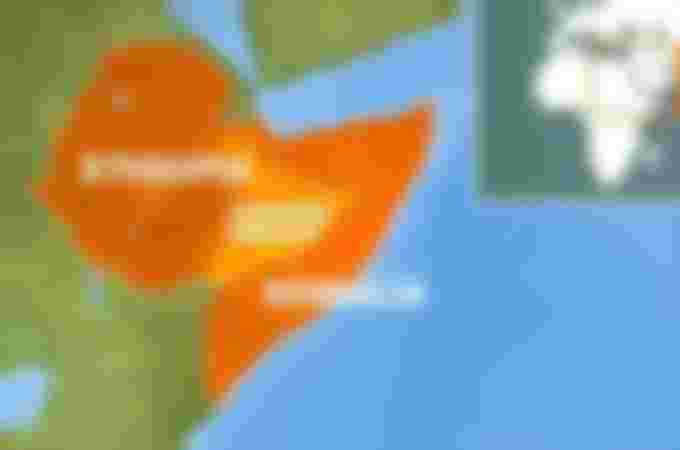Yesterday, I published Somalia - a failed state! and many people showed great interest in this topic, so I've decided to come up with a series of posts where I present the history of Somalia and the roots of how everything started and led to the state of Somalia today.
In recent decades, Somalia has become analogous to a failed state. It is known as a sanctuary for warlords, jihadists and even pirates. For this reason the country poses a security risk in the Horn of Africa.
However, it wasn't always like this. in fact, in mid 20th century the country was a powerful force in the region. so, in this post I will explore the decline of Somalia, the origins of its long-standing crisis and what issues the country faces today.
During the Middle Ages, several Somalia states dominated the region such as the Adal Sultanate, Ajuran Empire and Mogadishu Sultanate. However, the situation changed dramatically in the 19th century when European powers colonized the Horn of Africa. As a result British, French and Italian colonies were established in the territories that were inhabited by ethnic Somalis. The circumstances changed again following the outcome of World War II.

London needed to reward its east African allies and colonies for their support during the war. Therefore, artificial borders were designed in favor of the allied forces. For instance the Ogaden region which was mostly inhabited by Somalis, but conquered by the Ethiopians in the 19th century was solidified as part of Ethiopia. At the same time, Italian Somaliland and British Somaliland were merged into the newly established Somali Republic in 1960. Meanwhile, French Somaliland remained with France, but eventually parted ways and formed the Republic of Djibouti.
As European powers redesigned the borders, large portions of Somalis were left outside of Somalia. In Mogadishu, the government sought to seize the territories inhabited by its kin, a goal that became known as Greater Somalia. Eventually, in the early 1960s, tensions culminated in a skirmish between Ethiopia and Somalia over the Ogaden plateau. The Ethiopian Air Force overwhelmed the Somali army and won the fight. However, the clash would lead to future conflicts over the course of the Cold War. Then, suddenly, in 1969, president Shermarke Abdirashid of Somalia was shot dead by his own bodyguards. The assassination was followed by a military coup in which major-general Siad Barre seized power.
Barre's military government changed the dynamic of the region. He threw out the Constitution and dissolved the Parliament. Thereby, the young democratic government changed to a one party system. Over the next decade, Barre placed an emphasis on Islamic social principles of progress, equality and justice, which correlated with the Communist doctrine. These developments enabled the military government to swiftly modernize the state and society by implementing large-scale social programs such as cooperative farms, factories, literacy programs and even tree planting campaigns.

Barre raised socialist emphasis received the approval of Egypt and the Soviet Union. As a result, financial and military aid from these two countries increased dramatically. For Moscow, extending support to socialist Somalia was a Cold War countermeasure against the pro-American government in Ethiopia. For Cairo, however, the decision to support Mogadishu was based on securing the resources of the Nile by destabilizing Ethiopia. Either way, every involved player as looking out for their own interests.
Geopolitical tensions peaked in 1974 when the Ethiopian emperor, Haile Selassie, was overthrown in a coup. A Communist military council, known as the Derg, took control of the capital. However, the Derg quickly fell into an internal conflict over who would hold power. Distinct Derg factions as well as separatist movements rose up in arms. In the same year, a major drought hit the region. The Dryness was so severe that it was referred to as the Lingering Drought. With Addis Ababa in disarray, the geopolitical balance favored Somalia. Hence, Barre sees the opportunity to arm Somalis separatists in Ethiopia's Ogaden plateau.

At this point in history, the Somali military had developed into the largest and most advanced force in the region. Eventually, in 1977, emboldened by the circumstances, Somalia launched massive military operations into Ethiopia.
This is all for today. Tomorrow, the second episode of Somalia's history will be presented. Up until this moment, the situation was relatively calm, but what happens after the Somali invasion in Ethiopia is something that will define the current state of Somalia.
Stay tuned for the next episode!!
My successful faucets!
PipeFlare & Hive ZCash - ZEC with tier 4 referral program
FreeCryptos: (DASH), (TRX), (ETH), (Cardano), (BNB), (LINK), (NEO), (LTC) & (BTC)
Stakecube (over 20 single click faucets per day)
Join DeFi and get $30 of DFI. Join CakeDeFi now!!



Another top update on how the world goes 🌎